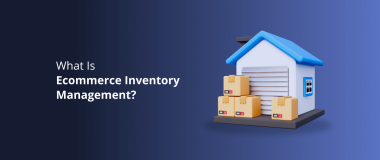As consumer expectations for lightning-fast shipping continue to rise, an advanced order management system (OMS) is essential for online retailers to keep up pace with demand.
In this article, we will take a look at what to consider when assessing your order management system options, which ones suit your needs the most and review the top OMS solutions and their user experiences. Keep on reading.
Readers Also Enjoy: What Is eCommerce Inventory Management? – DevriX
What Is an Order Management System in eCommerce and How Does It Work?
An order management system is the behind-the-scenes software that handles orders in an eCommerce business. When a customer places an order, the OMS kicks into action to manage that order through several key steps.
First, it registers the new order and assigns it a unique order number. Next, it sends the order details to the warehouse to fulfill. This means pulling the items from inventory, packing them, and shipping them out. As the warehouse processes the order, the system tracks its status so customers can check on their delivery.
A smart OMS also handles payment processing by integrating with payment gateways. This allows for collecting payment from the customer and managing transactions. Additionally, it can manage returns, refunds, and exchanges on orders.
The key purpose of such a system is to fulfill orders efficiently while keeping customers informed. Without it, online shopping wouldn’t work as effectively and customers wouldn’t be satisfied.

Benefits of an eCommerce Order Management System
An eCommerce order management system (OMS) allows a business to streamline their operations and improve customer satisfaction. Here are some key benefits:
- Centralized order processing. An OMS centralizes the processing of orders from multiple sales channels such as online stores, marketplaces, and brick-and-mortar shops. This streamlines order fulfillment and reduces the risk of errors.
- Inventory management. The system provides real-time inventory updates, helping businesses avoid overselling products and ensuring accurate stock levels. This is crucial for maintaining customer trust and preventing stockouts.
- Efficient order fulfillment. With automation features, businesses can efficiently pick, pack, and ship orders, reducing processing times and improving overall efficiency.
- Enhanced customer experience. By providing accurate order tracking information and timely notifications, an OMS contributes to a superior customer experience, leading to higher satisfaction and repeat business.
- Data insights. OMS platforms offer valuable insights into customer purchasing patterns, popular products, and seasonal trends. This data can inform inventory purchasing decisions and marketing strategies.
- Integration capabilities. Many OMS solutions integrate with other business systems, such as accounting software, customer relationship management (CRM) tools, and shipping carriers, creating a seamless workflow across the organization.
- Scalability. As businesses grow, an OMS can easily scale to accommodate increased order volumes and additional sales channels without sacrificing efficiency.
- Cost savings. By reducing manual errors, optimizing inventory levels, and streamlining operations, an OMS can lead to cost savings in the long run.
For larger brands managing hundreds or thousands of orders at once, expanding the mentioned OMS capabilities is crucial. Here is where considering ERP (Enterprise Resource Planning) comes into play. It is software that consolidates various business functions, including accounting and supply chain logistics, into a single solution.
As your brand grows and requires ERP support, it doesn’t necessarily replace your independent OMS. While an ERP handles similar functions to an OMS, a dedicated OMS typically offers the comprehensive capabilities essential for large eCommerce brands. Nevertheless, many modern ERPs now include advanced OMS software, providing an all-in-one solution.
The key advantage of an ERP is its ability to manage most of your business processes, offering a centralized view of inventory, shipping, OMS, and other eCommerce functions. However, the drawback is that an ERP may also lack the detailed, specific information you might need.
The Key Features of Order Management Systems for eCommerce
A good eCommerce OMS acts as the central command system for orders, connecting all stages of the fulfillment process while keeping the customer experience smooth. There are some core capabilities that any OMS needs to properly facilitate multichannel order fulfillment and reverse logistics.
Reverse Logistics
Seamless returns and exchanges keep customers happy and protect profit margins. An effective OMS enables clear reverse logistics by automatically generating return shipping labels for customers and identifying the most efficient return destination based on location. This simplifies back-end processing of refunds or replacements.
Integration Capabilities
Robust integration capabilities allow an OMS to sync orders, inventory, and customer data across business systems such as commerce platforms, CRM, and shipping providers.
Omnichannel Capabilities
Omnichannel order management means coordinating fulfillment across all sales channels to enable unified customer journeys. Whether someone orders online for in-store pickup or shops in person, but the item must be shipped from another location, the OMS maintains visibility and orchestrates logistics.
How to Choose the Best eCommerce Order Management System
When choosing the optimal OMS for your business, it’s important to make sure that the system’s overall features correspond to your particular requirements. Here’s how to do it:
- Assess your business needs. Begin by evaluating your current order management challenges, such as order volume, inventory complexity, and customer expectations. Identify the specific pain points and areas for improvement.
- Feature alignment. Ensure that the system offers essential capabilities such as order processing, inventory management, multi-channel integration, and reporting that align with your needs.
- Scalability. The OMS should be capable of handling increasing order volumes, expanding product lines, and integrating with additional sales channels as your business evolves.
- Integration capabilities. Compatibility and integration with existing systems, such as eCommerce platforms, accounting software, and customer relationship management (CRM) tools. Seamless integration can streamline operations and data flow.
- Customization options. Look for an OMS that offers ways to tailor the system to your specific workflows, business processes, and industry requirements.
- User-friendly interface. Ensure that the OMS provides an intuitive and user-friendly interface for your team members. Easy navigation and clear functionalities can enhance user adoption and productivity.
- Support and training. Reliable support, training, and maintenance can be invaluable when addressing technical issues and maximizing system utilization.
- Cost and ROI. Evaluate and consider the total cost of ownership, including implementation, licensing, and ongoing maintenance as well as the potential return on investment (ROI) in terms of operational efficiency, and improved customer satisfaction.
Readers Also Enjoy: 9 Tips for a Stunning eCommerce Customer Experience [2023 Guide] – DevriX

10 Order Management Systems for eCommerce
To assist eCommerce businesses in selecting the optimal order management system, we have compiled ten leading OMS solutions below that offer robust solutions to inventory, shipping, and returns.
- QuickBooks Desktop Enterprise: This system is best suited for small to medium-sized enterprises. It offers a wide range of features, including inventory management, order tracking, and invoicing.
Pros: Robust inventory management, easy-to-use interface.
Cons: Expensive, few customization options. - Brightpearl: Ideal for small companies that need an affordable solution. It offers features such as inventory management, order tracking, and shipping management.
Pros: Affordable, simple-to-understand interface.
Cons: Limited customization options, no mobile app. - Oracle NetSuite: It is a good option for mid-sized businesses.
` Pros: Comprehensive features, practical menus.
Cons: Limited customization options. - SAP Commerce Cloud: Best suited for companies that need an adaptable OMS. It features such items as inventory management, order tracking, and shipping management.
Pros: Easy-to-use interface, solid inventory management.
Cons: Expensive, limited customization options. - Orderhive: Good for small to medium-sized businesses. It has well-designed inventory management, order tracking, and shipping management.
Pros: Comprehensive features, easy to understand.
Cons: Expensive, limited customization options. - Zoho Inventory: Inexpensive option for small to medium-sized businesses. It has good inventory management, order tracking, and shipping management.
Pros: Easy to use interface.
Cons: Limited customization options. - Jotform: Good for small businesses that need a simple OMS. It offers features such as order tracking, payment processing, and shipping management.
Pros: Easy to use interface, affordable.
Cons: Limited customization options. - Linnworks: This system is best suited for small to medium-sized businesses.
Pros: Easy-to-use menus.
Cons: Expensive, limited customization options. - Google Forms: A free solution for small businesses. It offers features such as order tracking, payment processing, and shipping management.
Pros: Free, simple-to-understand interface.
Cons: Limited customization options, limited integration options, and only a few templates and fonts to choose from. - Odoo: This system offers features such as inventory management, order tracking, and shipping management and it is suitable for small and medium-sized businesses.
Pros: Comprehensive features, easy-to-use interface.
Cons: Expensive, few customizable options.
Readers Also Enjoy: 5 Reasons Your eCommerce Store Isn’t Performing – DevriX
Wrap Up
An order management system is an invaluable asset for eCommerce businesses looking to scale upward while continuing to provide exceptional customer experience. With an OMS that matches your needs, online retailers can transform everyday order fulfillment into a streamlined, omnichannel process. Investing in a decent OMS sets brands up for sustainable growth and satisfaction all around.




